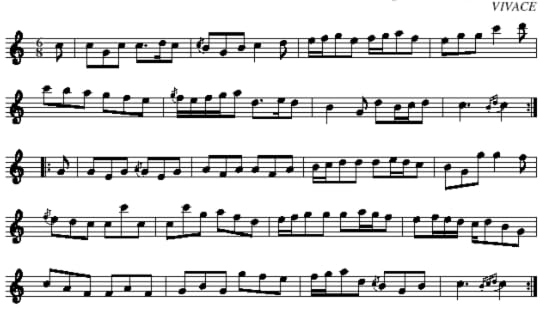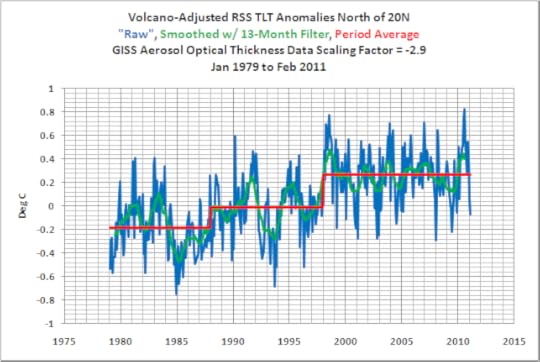Michael Flynn's Blog, page 56
March 17, 2011
The Wearin' o' the Green
Today is St. Patrick's Day, or as we Irish call it: "amateur night at the bars." In consideration of the day, we offer a bit of music. Normally, I don't like over-orchestrated harp music, but one takes what the net hauls in, and Fanny Po'er and O Carolan's Concerto are among my favorite O Carolan tunes.
But also his planxty "Uilliam O Flynn"

Midi file here: http://www.irishpage.com/songs/carolan/flynn.mid
The Flynns of Ballinlough (c.1000-1648)
The Flynns of the West were originally a Roscommon tribe: There is in Co. Roscommon the town of Ballinlough (Town-by-O Flynn's Lake) at the foot of Slievalynn (O Flynn's Mountain) and by the shore of the aforesaid lake. They came into possession of their rightful homeland in the time-honored fashion: by taking it from someone else; viz., the Conway tribes. This was when the Gaels were sweeping west and displacing the Picts.
The O Flynn* was one of the four Principle Chiefs whose assent was required to name a king in Connaught. In exchange, the O Flynn had the right to ride the king's horse. (I don't make this stuff up. The McGeraghty had the right to drink first at every banquet. To an Irishman that might have been the greater boon.) The clan controlled the Sil Maelruain, the southeast face of the O Conner kingdom. Another branch held the Claddagh, where Boyle Abbey is located. In 1224, when a rival O Conner made a bid for the kingdom, "all the chiefs forswore their oaths, save only Cormac McDermot, David O Flynn, and the rest of his officers." So they had a penchant for keeping their oaths.
(*O Flainn, O Floinn - the a or o is silent and served only to prevent the "l" from being palatilized)
The Annals of Connaught tell of some of the highjinks they pulled - like burning houses with people still in them, shooting a usurping king with an arrow, bushwhacking, being bushwhacked, and so on. Let's not pretend clan society was all rainbows and fluffy bunnies. It was an entire island of Hatfields and McCoys. Eventually, in the Composition of Connaught, the chiefs of the West surrendered their Gaelic titles and ranks and agreed to hold land under the English. The O Flynn (Fiachra O Flynn) was notable in that he did not sign the agreement. The next year his son was hanged in Ros Common Town, so we may assume that he resisted. We see thus that they are stubborn, even when losing.
The Flynns of Loughrea (1648-1865)
During the Cromwell War, an Order-in-Council was issued for the arrest of Fiachra O Flynn (a different Fiachra: it was a popular name in the clan) and a Collumb O Flynn was among the Wild Geese. (See "stubborn," above.) In the Book of Survey and Distribution, the clan lands were parceled out to the victorious English, and to Flynns as individuals. Local lore holds that one woman, a widow, said she would not undertake to live in her own house and pay rent to the English. (The Distribution Book mentions one woman: Onora Flynn. Is this her?) According to the locals in Ballinlough, she took her family to live with her own relatives down near Loughrea in the Co. Galway.The Flynns of New Jersey (1865-date)
 The Flynns, as such, trace our descent from Martin Flynn of Loughrea, Co. Galway, so chances are, we are descended from a stubborn old woman. Martin was b. 1803, and no image seems to have survived. He married one Honor Mahoney. His sons, incl. John Thomas Flynn, emigrated to America and the aforesaid John shows up in Washington NJ in time to get married to Anne Elizabeth Lynch (1865) and work in the railroad repair shops. They brought their father and sisters over later. The Lynches had come from Bannalynch, Co. Waterford, in the wake of the Famine; and "a few days after her parents landed in America," Anne was born in Burlington VT, which you may notice is not a seaport. The first Famine refugees went to Canada and sneaked across Lake Champlain. Those were the days of the Know Nothings, who wanted to keep Papists out of the country. The photograph is from a water-damaged portrait kept by a cousin of my grandfather. That entire side of the family has lost their Flynnish status by having too many daughters. The family names are all different now.
The Flynns, as such, trace our descent from Martin Flynn of Loughrea, Co. Galway, so chances are, we are descended from a stubborn old woman. Martin was b. 1803, and no image seems to have survived. He married one Honor Mahoney. His sons, incl. John Thomas Flynn, emigrated to America and the aforesaid John shows up in Washington NJ in time to get married to Anne Elizabeth Lynch (1865) and work in the railroad repair shops. They brought their father and sisters over later. The Lynches had come from Bannalynch, Co. Waterford, in the wake of the Famine; and "a few days after her parents landed in America," Anne was born in Burlington VT, which you may notice is not a seaport. The first Famine refugees went to Canada and sneaked across Lake Champlain. Those were the days of the Know Nothings, who wanted to keep Papists out of the country. The photograph is from a water-damaged portrait kept by a cousin of my grandfather. That entire side of the family has lost their Flynnish status by having too many daughters. The family names are all different now. John was killed on the railroad in 1881. When I was trying to find his death record, I did not yet know his name or the exact year; but I figured how many Flynns could be killed on the railroad in Washington, NJ, in the 1880s? The answer turned out to be 2. The other was his younger brother. (This actually led to the uncovering of an entirely unknown cadet branch of the clan!) There was a third Flynn, also named John, also married to an Ann, also with several children bearing the same names. But no relation.
The rest, as they say, is history.





I should add one other Irish connection. Francis Thomas Flynn (2nd from left) married a woman whose mother came from Co. Cavan. She was Mary McGovern. There was a remote and inaccessible region of Cavan known as the Glan, wherein lived (as the Topographical Dictionary states) a primitive race of McGoverns and Dolans, who married one another and who annually elected the "King of the Glan" from among the ancient race of McGoverns. They seem to be descended from the notorious Squint-Eyed Terry McGovern who got into a feud with the Dolans over his daughter's elopement. In any case, Mary was a school-teacher in Cavan and her parents were Matthew McGovern and Katherine Dolan.
It's a Big Spiral Arm
For those who missed Pi Day on 3/14 be aware that pi in duodecimal notation is
3.184809493#918664573X6211##151551X05729290X7809X492..
(where X is 10 and # is 11 compressed to single digits)
Since the Confederation of Central Worlds and the Old Planets in the United League of the Periphery use dodeka time, that is: base 12, it is only fair to give them a shot. Especially since the clock face has 12 hours and the year has 12 months. So celebrate on March 18th.
Thus, there has always been a tension between useful measures (inches, ounces, feet, yards, etc.) tied to the human body and easily calculable measures (multiples of 10). Two solutions were possible: change the measures to multiples of ten; or.... change the arithmetic to base 12.
It is not clear how the bulk of the Periphery (High Tara, Ramage, Valency, Foreganger, Hawthorn Rose, New Eireann, Jehovah, et al.) wound up with a metric time system of a normal human heartbeat building up in multiples of ten, while the Old Planets (Old 'Saken, Die Bold, Friesing's World, Bandonope, Kauntusulphalughy, Abyalon, Megranome, et al.) retained the old Commonwealth system of a beat building up in multiples of 12. Since time was no longer tied to the rotation of one particular planet or the cycle of its moon or its revolution round its sun (not to speak of the number of planets visible by eye - 7) there was no need for either metric time or dodeka time to match that of Earth. However, by a curious coincidence, one dodeka day (or "doo-dah" day) is precisely equal to a Terran day, while a metric day (1 kilominute) is just tiny bit shorter (0.96).
March 16, 2011
Wondertheory of the Ages

March 14, 2011
Mathetopia
Today is Pi Day. So along with the Alamo and the Maine, remember the pi.
π r²
But as a friend once told me, "Pie are not square; pie are round. Cornbread are square."
 If we superscribe a circle with squares of side r, it is clear that the area of the circle is less than four of these squares (left). Four such squares is 4r². If we inscribe the circle with squares of diagonal r, the area of the circle is clearly greater than four of these squares. Thanks to Mr. Pythagoras, we know that if the diagonal is r, the side is SQRT(2X), so the area is r²/2. Four of these is 2r². Therefore, the area of a circle must lie between 2r² and 4r², and 3r² seems a reasonable guess. If not for those curvey lines.... So it turns out to be "a little bit more than 3." To wit:
If we superscribe a circle with squares of side r, it is clear that the area of the circle is less than four of these squares (left). Four such squares is 4r². If we inscribe the circle with squares of diagonal r, the area of the circle is clearly greater than four of these squares. Thanks to Mr. Pythagoras, we know that if the diagonal is r, the side is SQRT(2X), so the area is r²/2. Four of these is 2r². Therefore, the area of a circle must lie between 2r² and 4r², and 3r² seems a reasonable guess. If not for those curvey lines.... So it turns out to be "a little bit more than 3." To wit:3.1415926535897932384626433832795028841971693993751058209749445923078
164062862089986280348253421170679821480865132823066470938446095505822
317253594081284811174502841027019385211055596446229489549303819644288
109756659334461284756482337867831652712019091456485669234603486104543
266482133936072602491412737245870066063155881748815209209628292540917
15364367892590360011330530548820466521384146951941511609...
How's that for a pi in the face? All hail, the mighty PI.
However, there is seldom need for anything more than 3.14159; or even 3.1416, if we round. Every really real circular object can be measured to a specific number of decimal places, and so the ratio C/d will always be a rational number, no matter how many decimals are in our instrument. So what is this "irrational" pi anyway but a pure spirit, not found anywhere in the real world? Hunh? Credulous believers in PI even call it "irrational," but "rationalists" know there is no such thing in reality. A fig for your pi.
There is apparently a movement afoot to replace π with 2π in radial formulae, calling it τ (tau). There is a certain elegance in notation in trig if you do this. Unfortunately, the area of the circle becomes τd²/8 (or τ r²/2 if you prefer), which is not so elegant. The circumference of a circle is 2π r, which would be τ r. So τ is the ratio of the circumference to the radius (C/r) while π is the ratio of the circumference to the diameter (C/r) or the ratio of the area to the squared radius (A/r²). Notationally, tau may simplify linear formulae while pi makes more elegance dealing with square formulae. Perhaps we should define a number for V/r³.
March 12, 2011
On this day in history...
Back in 1853, the folk who lived atop German Hill had desired to build their own church rather than climb down the cliffs, cross the river, and climb the hill on the other side to attend St. Bernard's. Too many Irish there, anyway. So they built a church atop German Hill: white-washed brick with a steeple in front. The church was dedicated by the fourth bishop of Philadelphia, Rev. John Neumann, who was one of two saints associated with the parish. (The other was Dorothy Day, who established a Catholic Workers farm on Morgan's Hill.)
 But by 1885, the old white-washed brick church was too small for the German congregation. During the funeral of Fr. John B. Frisch, the seventh pastor, people had knelt in the grass outside all day, in the pouring rain. Though perhaps this was as much a tribute to the greatness of the man as to the smallness of the building. A new church was built on the same site.
But by 1885, the old white-washed brick church was too small for the German congregation. During the funeral of Fr. John B. Frisch, the seventh pastor, people had knelt in the grass outside all day, in the pouring rain. Though perhaps this was as much a tribute to the greatness of the man as to the smallness of the building. A new church was built on the same site.
This was the life's work of Fr. James Regnery, 13th pastor of St. Joseph. He found the church nearly in ruins, the school inadequate and the sisters’ residence in poor condition. Also, he was confronted by a debt of $11,000 – and this was in 1885 gold dollars! “Being fitted by nature and grace as a genius of finance,” Fr. Regnery was equal to the task and liquidated the debt, refurbished the convent to provide bright and cheery quarters for the sisters, and then turned his attention to the church building.
Read More About The Great Fire even though "too big" for LiveJournal
March 11, 2011
Statistopia
Here is an illustration of the limitations of linear thinking alluded to in a previous statistical post: When is an Average Not an Average? Both charts involve everyone's favorite topic: Global Warming/Climate Change/Climate Disruption.
The first is a time series of the satellite data compiled by RSS [Remote Sensing Systems]. The series, plotted by Bob Tisdale, was for the purpose of comparing the recent revision of the data algorithm -- certain satellite feeds have been added, others discounted or weighted differently -- to the previous revision. (Overall effect is that v.3.3 produces slightly cooler temps than v.3.2) But our purpose here is to observer the linear regression thrown through the data series, for everyone needs a good laugh now and then. Now I hesitate to say that no one but a scientist would dare try to fit a linear trend to what is clearly a non-linear time series; and in fact Tisdale will take it further shortly. But one sees this sort of thing constantly. A linear trend indicates a single cause which moves the data continually in the same direction up to a boundary condition or causal regime change. For example, the speed of a falling apple will increase uniformly under the influence of the single cause of gravitational acceleration -- up to the point it strikes you on the head. A certain amount of noise can be expected around the regression line due to, among other things, measurement system variation.
But in actual processes, it is not uncommon to find multiple causes operating simultaneously. Random variation is due to common causes; i.e., causes that are "commonly present" all or most of the time. Random variation will produce cumulatively a statistical distribution, such as the normal, lognormal, Poisson, extreme value, etc. Spikes (or Icicles) are due to transient special causes that happen at a particular time. Shifts are due to a special cause that occurs at a particular point in time, raising or lowering the process mean. Variation before and after the shift is random around the old mean and the new mean, resp. Trends are due to a special cause that occurs during a span of time, as mentioned above. Cycles are due to a special cause that occurs repeatedly at more-or-less-equal intervals of time. These are simple patterns, so-called because there is a simple (direct) relation between the nature of the pattern and the time sequence of the data. For complex patterns, the root cause is not tied into the time sequence, per se. These include Stratification, Mixtures, etc. The pattern called Instability (or Chaos) usually indicates the presence of more than one special cause, and it is the object of the analyst to "parse" the variation into its individual components, either through re-analysis of the data: a) chart-matching, b) breakdown, c) replot; or through "active statistics": d) elimination of a factor, e) designed experiment.
Which brings us back to the chart above. In an industrial situation, variables are removed by the simple act of actually removing them. In a famous capability study at the old Western Electric, the first variable suspected was operator over-adjustment of a certain machine setting; and this was removed by telling the operator to keep his cotton-picking fingers off the knob. The before-and-after charts showed a marked decrease in variation and revealed a mixture pattern that identified a loose fixture. When the fixture was, well, fixed, a skewness identified premature removal of the parts from their chucks; and so on until the chart was in a state of statistical control: i.e., the variation was indistinguishable from random variation.
For found data, however well-massaged they may be, this is not practical. So what folks normally do is determine an equation that describes the effect of the variable X on the charted values of Y, and then plotting the residual Ŷ = Y - f(X). So Tisdale adjusted the RSS data for the effect of volcanic eruptions (anthropogenic volcanic eruptions?) using Goddard Institute's Aerosol Optical Thickness data for the amount of particulates in the atmosphere. We won't worry here about how he may have done the regression, as that is not our topic du jour. The result of his adjustment for vulcanism is below:

The red lines are the volcano-adjusted mean values for the time intervals between major ENSO events (El Niño/La Niña-Southern Oscillation). The green line is a 13-month rolling mean. Rolling means are generally used to smooth out local fluctuations and look for trends. This "step-wise" increase in temperature seems to have a smaller mean square than the straight linear trend in the first graph, which among the statistical fraternity inclines the mind to regard it more favorably.
But in consequence, the mind is led away from a single cause operating continuously across a time interval, and toward a series of "kicks" that shift the process from one mean to another. These kicks seem to be related to the ENSO events; i.e., ENSOs seem to have persistent effects.
I am not entirely convinced -- the middle phase seems weak to me, and he is only looking at northern hemisphere -- but it illustrates the empirical approach to the data. Instead of springing a linear regression through the data, start from the data and look for signals in the time series, identify the source of the signal, remove it (physically or mathematically) and look for another signal.
What you should avoid is the top-down approach: brainstorm a bunch of factors that you think might be important, build a model using those factors, adjust the model coefficients so the model outputs are kinda like the actual data, then declare that other factors are unimportant because your model leaves no room for them. It is well known that with seven factors you can fit any set of data, providing only that you can play with the coefficients. This gives the illusion that the chosen coefficients reflect real-world relationships and that collectively the chosen factors account for virtually all the variation.
March 6, 2011
SF ga yomitai!
 The annual SF ga yomitai! has just been published in Japan, and I have the go-ahead to tell you this. In a letter to my agent last month, we were told the following:
The annual SF ga yomitai! has just been published in Japan, and I have the go-ahead to tell you this. In a letter to my agent last month, we were told the following:Tokyo Sogensha, the Japanese publisher for Michael Flynn's Eifelheim, has just brought us great news. Eifelheim has just been chosen as the "Best SF for 2010." It's a ranking organized by an annually-published SF guidebook, SF ga yomitai! (We Want to Read SF!). The ranking is decided by SF writers, editors and critics; and Eifelheim got a No. 1 in the ranking for foreign SF novels for which Japanese editions were published in 2010.
 This is not the Seiun Award, but a ranking voted on as we are told by "writers, editors, and critics." Coming on top of the French Prix Julia Verlanger, Eifelheim seems to be getting more than a few nods elsewhere. (French cover to right→)
This is not the Seiun Award, but a ranking voted on as we are told by "writers, editors, and critics." Coming on top of the French Prix Julia Verlanger, Eifelheim seems to be getting more than a few nods elsewhere. (French cover to right→)The truly remarkable thing is that the main setting (14th century Black Forest) and the context (Aristo-Thomist philosophy, European feudalism) would seem incredibly alien to Japanese readers, although there may be elements of similarity with samurai culture. Well, for SF readers, the exploration of alien worlds may be part of the charm. But I still wonder how they translated some of the terms! Great credit must be given to the translator to take such a particular text and transform it for such an utterly different language. His name, I am told is Youichi Shimada. So a great deal of credit must go to him. (Or her.)
Statistopia
You can't argue with the facts. Observe the UN FAO Food Price Index:
[image error]
Now, it turns out that wheat held steady and rice declines slightly, so the increase is due mainly to maize (corn). The biggest exporter of maize is the US, and this past year, 40% of the US maize crop went to ethanol rather than into food. That's 40%. So, yes, food crops have decreased due to global warming; viz., the hysteria over it has diverted food away from the mouths of the poor into the gas tanks of the well-to-do in order that they may feel really good about their moral superiority.
Sorry for the intemperate remarks, but I'm one of those "feed the hungry" nuts.
March 5, 2011
Bear with us
My brother K sent me this link. He used to work for a newspaper, but the newspaper folded under the pressure of things like this. Warning: there is naughty language used in the report.
</div>
Michael Flynn's Blog
- Michael Flynn's profile
- 237 followers



